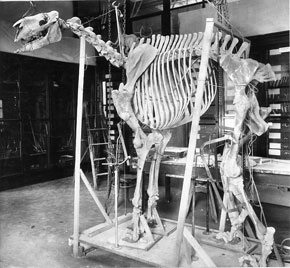Introduction
How do we know what we know about the evolution of perissodactyls and the environments in which they lived? What is the evidence for this?
The most important source of evidence are the fossil remains of extinct perissodactyls. The AMNH fossil mammal collection contains 18,919 catalogued specimens of perissodactyl in 151 different genera and around 45,000 uncataloged specimens. These range from single teeth and jaw fragments to whole skeletons, and include a vast range of different animals, from the early horse Hyracotherium, which was the size of a small dog, to the giant Indricotherium, the largest known land mammal.
By comparing the teeth and bones of different types of perissodactyl, we can gather evidence on how they may be related. But the fossils can tell us other things as well. By looking at microscopic scrapes and scratches on the surface of teeth, we can reconstruct the diet of long-extinct animals. The fossils of other animals and plants found alongside these extinct perissodactyls can help us reconstruct the communities in which they lived. And we sometimes discover whole herds of animals that died at the same time, which provides us with a snapshot of a whole population and give us some insights into their behavior and ecology.
This section looks at how we find fossils, how we get them back to the museum, and what we do with them when they get there. What do we do to look after them, and how do scientists use them to learn about evolution?

